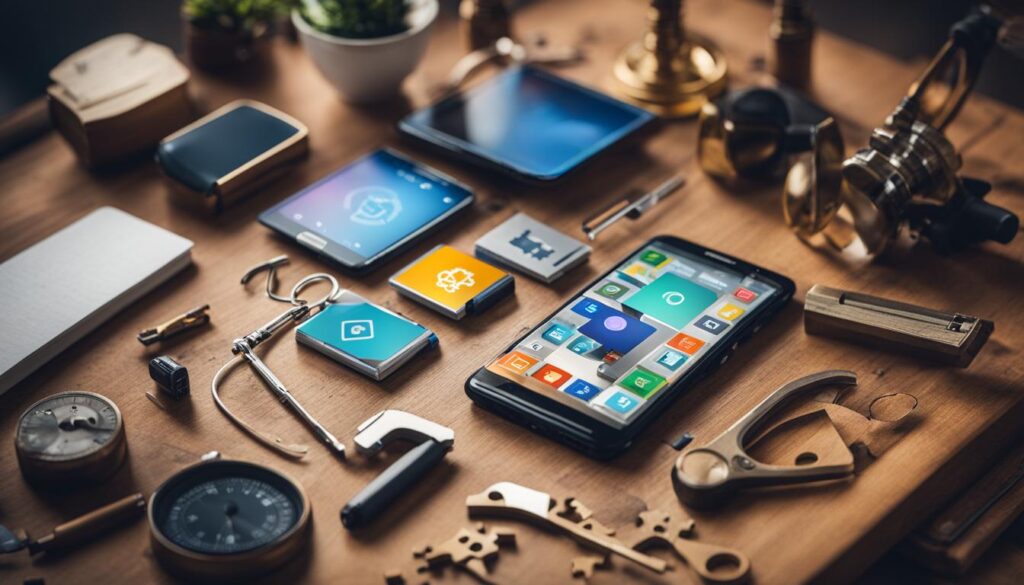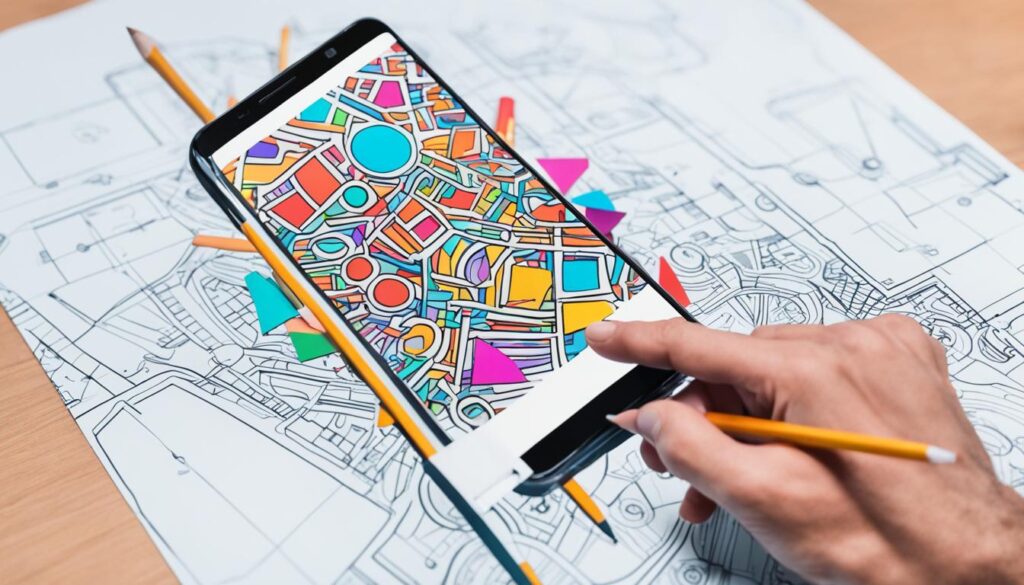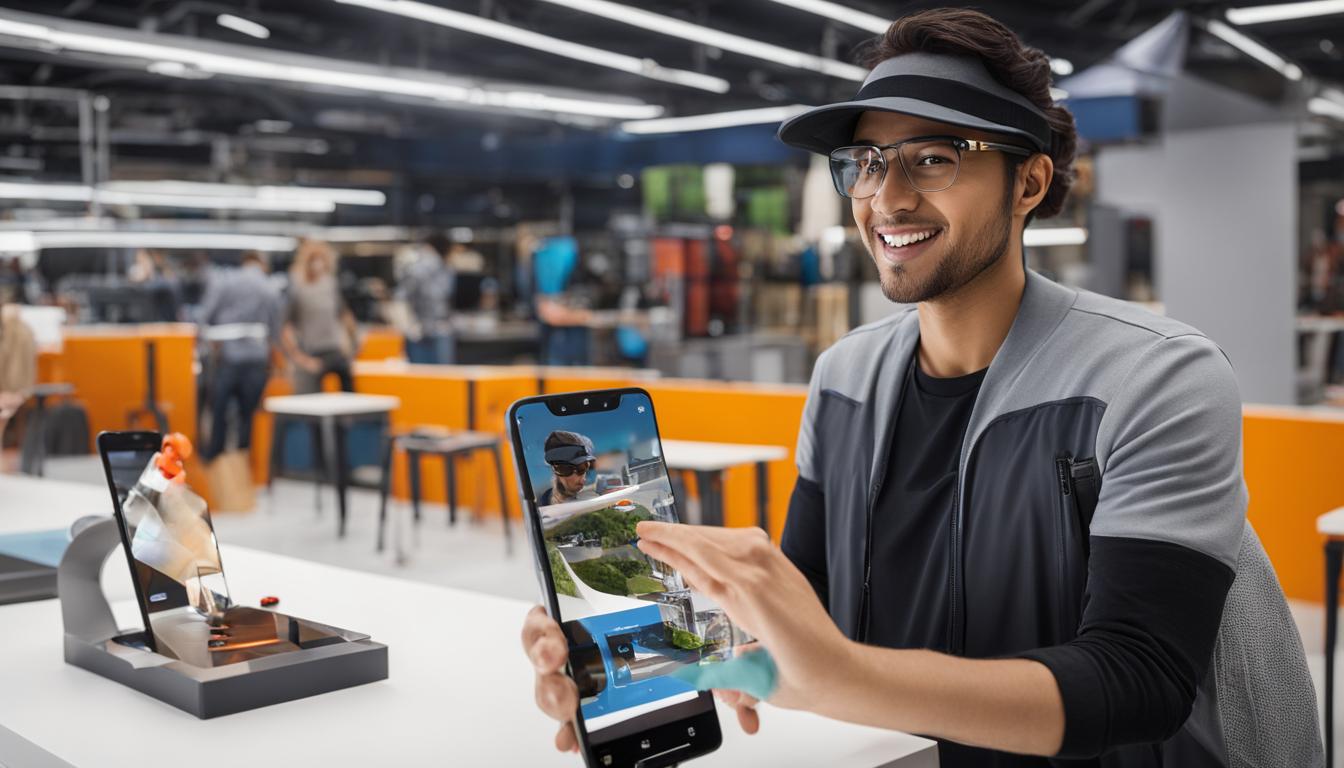Augmented Reality (AR) has become increasingly popular in various fields, including entertainment, gaming, healthcare, education, retail, and business. With the advancement of technology, creating AR apps for Android has become more accessible. In this article, we will provide a step-by-step guide on how to create augmented reality apps for Android using popular tools and frameworks.
Contents
- 1 Understanding Augmented Reality Development in Android
- 2 Choosing the Best SDK for Augmented Reality Development on Android
- 3 Steps to Create an Augmented Reality App for Android
- 4 Recommended Tools for Augmented Reality Creation on Android
- 5 Conclusion
- 6 FAQ
- 6.1 How do I create augmented reality apps for Android?
- 6.2 What is augmented reality development in Android?
- 6.3 Which SDK should I choose for augmented reality development on Android?
- 6.4 What are the steps to create an augmented reality app for Android?
- 6.5 What tools can I use to create augmented reality experiences on Android?
- 7 Source Links
Key Takeaways:
- Learn how to create augmented reality apps for Android using popular tools and frameworks.
- Understand the basics of augmented reality development in Android and the different types of AR.
- Choose the best SDK for augmented reality development on Android based on your project requirements.
- Follow the step-by-step process to create an AR app for Android, from defining app requirements to testing.
- Explore recommended tools for augmented reality creation on Android.
Understanding Augmented Reality Development in Android
Augmented Reality (AR) development in Android involves leveraging the device’s camera and image recognition capabilities to superimpose digital objects onto the real world. This technology has gained immense popularity across various industries, offering innovative and immersive experiences to users.
There are different types of AR experiences that can be developed for Android devices, each with its own unique characteristics:
- Location-bound AR: This type of AR is tied to specific locations and utilizes GPS coordinates to trigger digital overlays in real-time. It enhances the user’s environment and provides location-based information or interactive elements.
- Marker AR: In marker-based AR, predefined markers or images act as triggers for overlaying digital content. When the camera recognizes the marker, it anchors relevant digital objects onto it, creating an augmented view.
- Markerless AR: This type of AR relies on advanced computer vision algorithms to detect and track the environment without the need for markers. It allows for more natural and seamless integration of digital content into the real-world surroundings.
- Projection-based AR: Using projectors or holographic displays, projection-based AR projects digital content directly onto physical objects or surfaces. This technology creates interactive, dynamic augmented experiences.
To enable AR development in Android, developers utilize specialized tools and frameworks. One such technology is ARCore, a platform by Google that provides the necessary APIs and functionalities for building AR experiences on Android devices. ARCore enables motion tracking, environmental understanding, and light estimation, allowing developers to create realistic and interactive AR applications.
Sceneform is another essential component of AR development in Android. It is a 3D framework by Google that simplifies the process of rendering 3D models in AR applications. With Sceneform, developers can import, view, and interact with 3D assets, making it an integral part of creating visually compelling AR experiences.
By harnessing the capabilities of ARCore and Sceneform, developers can bring their creative visions to life and deliver captivating AR applications for Android devices.
Choosing the Best SDK for Augmented Reality Development on Android
Selecting the right Software Development Kit (SDK) is crucial for augmented reality development on Android. With the availability of multiple options, it’s important to choose the best SDK that aligns with your project requirements and objectives.
Top SDKs for AR Development on Android
Here are some of the best SDKs for AR development on Android:
- ARCore: ARCore, developed by Google, is one of the most popular SDKs for Android. It offers features such as motion tracking, environmental understanding, and light estimation, allowing developers to create immersive and realistic AR experiences.
- Sceneform: Sceneform is an SDK powered by ARCore that simplifies the process of creating AR apps by providing a high-level API and tools for visualizing 3D objects in AR. It integrates seamlessly with popular game engines like Unity and Unreal Engine, making it a great choice for game developers.
- Vuforia: Vuforia is a robust SDK that excels in image recognition and tracking. It enables developers to build AR applications that detect and track real-world objects, making it ideal for applications in fields such as industrial maintenance, retail, and education.
- EasyAR: EasyAR is a user-friendly SDK that offers powerful AR capabilities such as instant tracking, 3D object tracking, and image recognition. It supports both marker-based and markerless AR, making it suitable for a wide range of AR applications.
Each SDK comes with its own strengths and limitations, so it’s essential to evaluate your project requirements and consider the features offered by each SDK. Additionally, consider factors such as community support, documentation, and compatibility with your existing development environment.
By choosing the best SDK for augmented reality development on Android, you can unlock the full potential of AR technology and deliver captivating experiences to your users.

| SDK | Features | Integration | Applications |
|---|---|---|---|
| ARCore | Motion tracking, environmental understanding, light estimation | Native support, Unity, Unreal Engine | Gaming, entertainment, education |
| Sceneform | High-level API, 3D object visualization, ARCore-powered | Unity, Unreal Engine | Game development, architectural visualization |
| Vuforia | Image recognition, object tracking | Unity, native support | Industrial maintenance, retail, education |
| EasyAR | Instant tracking, 3D object tracking, image recognition | Unity, native support | Marketing, advertising, interactive experiences |
Steps to Create an Augmented Reality App for Android
Creating an augmented reality app for Android involves several key steps. By following these steps, you can bring your innovative AR ideas to life and deliver an engaging user experience. Let’s dive into the process:
- Define App Requirements and Functionality: Begin by clearly defining the requirements and functionality of your AR app. Consider the purpose of your app and the specific features you want to incorporate. This initial step will help guide your development process.
- Select the Appropriate SDK: Once you have defined your app requirements, choose the most suitable Software Development Kit (SDK) for your project. Popular SDKs for Android AR app development include ARCore, Sceneform, Vuforia, and EasyAR. Evaluate their features, documentation, and compatibility with your desired functionality.
- Design the User Interface and User Experience: Designing an intuitive and visually appealing user interface (UI) is crucial for the success of your AR app. Consider how users will interact with the app’s augmented elements and ensure a seamless integration between the digital and real-world environments.
- Implement Functionality with the Selected SDK: Utilize the chosen SDK to implement the desired functionality in your AR app. Leverage the SDK’s capabilities for features like motion tracking, object recognition, and spatial mapping. This step requires coding expertise in languages such as Java or Kotlin.
- Test and Debug: Thoroughly test your AR app to ensure its functionality, stability, and compatibility across different Android devices. Conduct comprehensive testing for various scenarios and edge cases. Regress any defects encountered during testing and optimize your app’s performance accordingly.
- Refine and Enhance the User Experience: Continuously gather user feedback and refine your AR app to provide an optimal user experience. Pay attention to user interactions, app responsiveness, and overall performance. Regularly incorporate updates and new features to keep your app competitive in the market.
By following these steps, you’ll be well on your way to creating an impressive augmented reality app for Android. Deliver captivating experiences that blend the virtual and real worlds seamlessly.

Example Table:
| Step | Description |
|---|---|
| 1 | Define App Requirements and Functionality |
| 2 | Select the Appropriate SDK |
| 3 | Design the User Interface and User Experience |
| 4 | Implement Functionality with the Selected SDK |
| 5 | Test and Debug |
| 6 | Refine and Enhance the User Experience |
Recommended Tools for Augmented Reality Creation on Android
When it comes to creating augmented reality experiences on Android, having the right tools can make all the difference. Here are some of the recommended tools for AR creation on Android:
1. ARize
ARize is a powerful AR platform that allows you to create stunning AR experiences without any coding knowledge. With ARize, you can easily add 3D models, videos, and links to your AR creations. The platform is user-friendly and offers a wide range of features to bring your ideas to life.
2. Arloopa Studio
Arloopa Studio is a versatile tool that enables you to create AR apps and experiences for Android. It offers a variety of features, including image recognition, 3D object tracking, and interactive content. With Arloopa Studio, you can easily build immersive AR projects and share them with others.
3. Assemblr Studio
Assemblr Studio is a popular choice for AR development on Android. It allows you to create interactive AR scenes by simply dragging and dropping 3D models, images, and videos. With its intuitive interface, you can easily customize your AR experiences and create engaging content.
4. EyeJack
EyeJack is a unique AR app that lets you create augmented reality experiences using your own artworks. With EyeJack, you can bring your creations to life by adding animations, videos, and interactive elements. It’s a perfect tool for artists and designers looking to explore the possibilities of AR.
5. Halo AR
Halo AR is a comprehensive AR platform that offers a range of features for Android app development. It provides tools for marker-based and markerless AR, as well as real-time 3D object tracking. With Halo AR, you can create immersive AR experiences with ease.
6. WebAR
WebAR is a web-based AR solution that allows you to create AR experiences that can be accessed through web browsers on Android devices. With WebAR, you can easily publish and share your AR projects without the need for users to download a separate app.
When choosing a tool for AR development on Android, consider factors such as cost, platform compatibility, ease of use, and the desired features for your project. These recommended tools offer a range of capabilities to help you create captivating and interactive augmented reality experiences on the Android platform.

Conclusion
In conclusion, the availability of various SDKs and development tools has made creating augmented reality apps for Android more accessible than ever before. With the right tools and a step-by-step approach, you can unleash your creativity and build immersive AR experiences that cater to diverse needs.
Augmented reality offers endless possibilities for app development on the Android platform, whether it’s for gaming, education, or business purposes. By leveraging technologies like ARCore, Sceneform, Vuforia, and EasyAR, you can harness the power of image recognition, motion tracking, and 3D object tracking to deliver captivating and interactive AR experiences.
As you embark on your AR app development journey, don’t forget the importance of designing a user-friendly interface and thoroughly testing your app to ensure its functionality. With the support of recommended tools like ARize, Arloopa Studio, Assemblr Studio, EyeJack, Halo AR, and WebAR, you can enhance your app’s features and create compelling AR experiences.
Whether you’re a beginner or an experienced developer, the world of augmented reality on Android awaits your exploration. Take advantage of the resources and technologies available, and let your imagination run wild as you immerse your audience in a new dimension of reality.
FAQ
How do I create augmented reality apps for Android?
To create augmented reality apps for Android, you will need to follow a step-by-step process that includes defining your app requirements, selecting the appropriate SDK, designing the user interface, and thoroughly testing the app before release.
What is augmented reality development in Android?
Augmented reality development in Android involves using the device’s camera and image recognition capabilities to overlay digital objects onto the real world. It relies on technologies such as ARCore and Sceneform to create immersive AR experiences.
Which SDK should I choose for augmented reality development on Android?
There are several SDKs available for augmented reality development on Android, including ARCore, Sceneform, Vuforia, and EasyAR. Each SDK has its own strengths and limitations, so it’s important to choose the one that best suits your project requirements.
What are the steps to create an augmented reality app for Android?
The steps to create an augmented reality app for Android include defining your app requirements, selecting the appropriate SDK, designing the user interface, and thoroughly testing the app before releasing it to the public.
What tools can I use to create augmented reality experiences on Android?
There are several recommended tools for creating augmented reality experiences on Android, including ARize, Arloopa Studio, Assemblr Studio, EyeJack, Halo AR, and WebAR. These tools offer different features and capabilities, so it’s important to consider factors such as cost, platform compatibility, ease of use, and desired features when choosing a tool.




